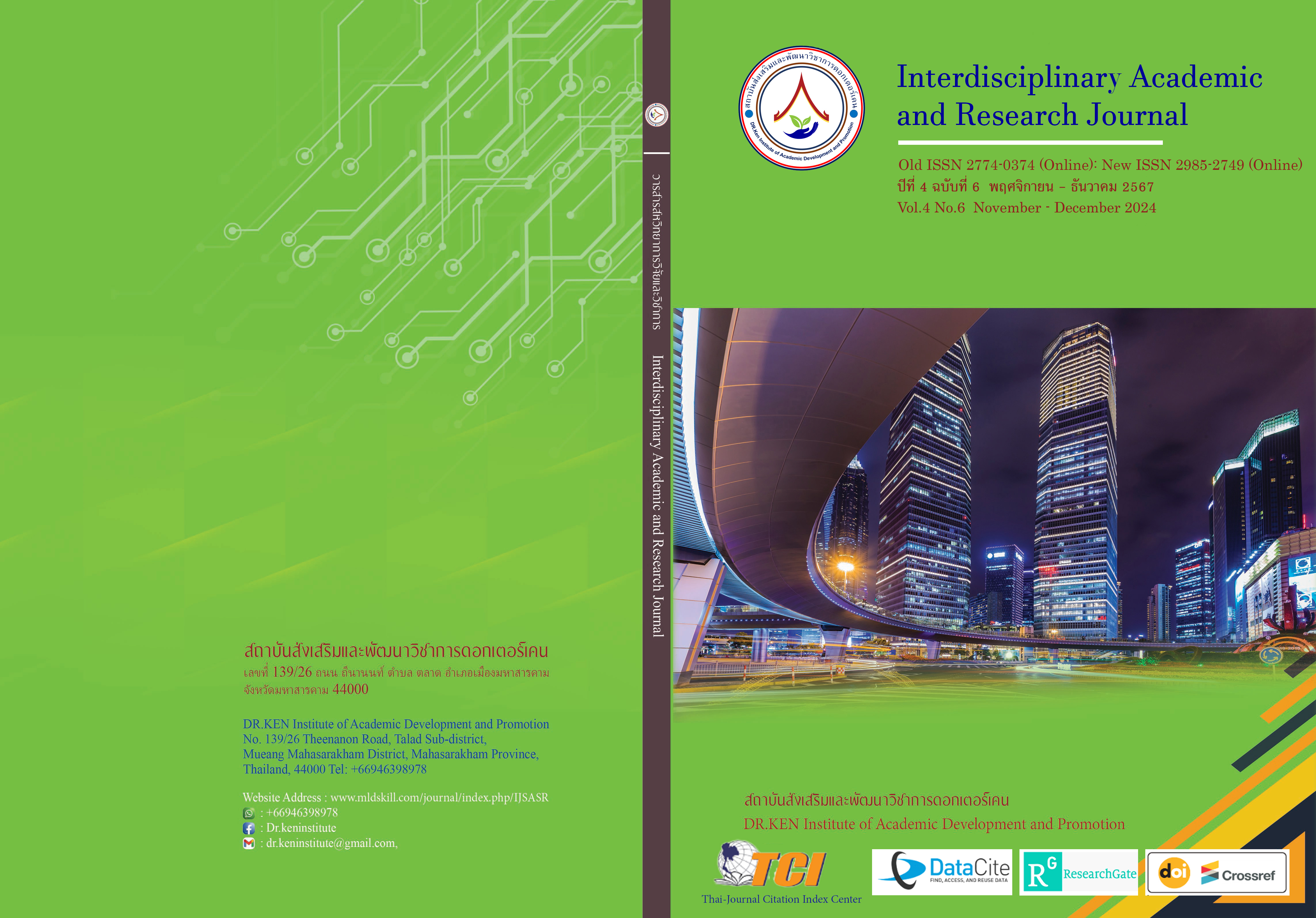Integration of Buddhist Principles for Promote People's Participation in Community Development Wang Nang Municipality, Mueang District, Maha Sarakham Province
DOI:
https://doi.org/10.60027/iarj.2024.281502Keywords:
Integration, Inclusion Wanorn, Community DevelopmentAbstract
Background and Objectives: The objectives of this thesis are 1. To study the participation of the public in the development of the community of Wang Nang Municipality. 2. To compare public participation with the development of the community of Wang Nang Sub-district. 3. To present the integration of Buddhist principles to promote public participation in the development of the Wang Nang Municipal Community. Mueang District, Mahasarakham Province
Research Methodology: This research is an integrated research that surveys populations using a data collection method calculated from the formula of Taro Yamane. The statistical data were analyzed by finding the frequency, percentage, mean, standard deviation, and inferential statistics by finding the Pearson correlation coefficient. In qualitative research, in-depth interviews with key informants living in Wang Nang Sub-district Municipality were used. The data were analyzed using contextual content analysis techniques and data synthesis according to the objectives of the research.
Research Findings: 1. Public Participation in the Development of the Wang Nang Municipal Community The overall level of public participation in the principle of Sarani Dhamma 6 is very high, and the participation of the people in community development is very high. 2. Comparison of public participation with community development in Wang Nang Sub-district Classified by personal factors, it was found that gender, age, education level, occupation and income were different. Participation in local development is no different. Therefore, the research hypothesis is rejected 3. Presentation of the integration of Buddhist principles to promote public participation in the development of the community of Wang Nang Municipality. It was found that to promote public participation in community development, the principles of the Dharma should be applied in operation. To make the management of community development more effective.
Conclusion: The results of this study show the public participation of Wang Nang Sub-district Municipality and the contribution of the people to community development according to the principle of philosophy 6 as a whole, and the participation of the people in community development. In Wang Nang Sub-district Municipality, the overall level is moderate. The results of the comparison of public participation in the development of the community in Wang Nang Sub-district by classification by personal factors showed that gender, age, education level, occupation and income were different. There is no difference in participating in local development, and the integration of Buddhist principles should promote public participation in community development. In order to make the management of community development more effective.
References
เกรียงศักดิ์ เจริญวงศ์ศักดิ์. (2546). การคิดเชิงวิเคราะห์. พิมพ์ครั้งที่ 3. กรุงเทพฯ: ซัคเซสมีเดีย.
ธันยวัฒน์ รัตนสัค. (2555). การบริหารราชการไทย. เชียงใหม่ : สำนักวิชารัฐประศาสนศาสตร์ คณะรัฐศาสตร์และรัฐประศาสนศาสตร์ มหาวิทยาลัยเชียงใหม่.
พรธิดา วิเศษศิลปานนท์ และคณะ. (2556). โครงการติดตามการเข้าถึงสิทธิของคนพิการและการพัฒนา รูปแบบระบบสวัสดิการที่ส่งเสริมการเข้าถึงสิทธิของคนพิการ. กรุงเทพฯ: กรมส่งเสริมและพัฒนาคุณภาพ ชีวิตคนพิการ.
พระเกรียงศักดิ์ กิตฺติปัญโญ (รักสนิท). (2560). การมีส่วนร่วมของประชาชนในการกําหนดนโยบายการพัฒนาชุมชนขององค์การบริหารส่วนตําบลประสงค์ อําเภอท่าชนะ จังหวัดสุราษฎร์ธานี. วิทยานิพนธ์พุทธศาสตรมหาบัณฑิต สาขาการพัฒนาสังคม. บัณฑิตวิทยาลัย : มหาวิทยาลัยมหาจุฬาลงกรณราชวิทยาลัย.
พระธวัชชัย สนฺติธมฺโม (วรรณนาวิน). (2561). การมีส่วนร่วมของประชาชนในการพัฒนาชุมชนในเขตเทศบาลเมืองสระแก้ว จังหวัดสระแก้ว. สารนิพนธ์รัฐประศาสนศาสตร์มหาบัณฑิต. บัณฑิตวิทยาลัย : มหาวิทยาลัยมหาจุฬาลงกรณราชวิทยาลัย.
พระมหาสุริยะ มทฺทโว (มาธรรม). (2564). การประยุกต์หลักสาราณียธรรมเพื่อส่งเสริมความผูกพันต่อองค์กรของบุคลากรเทศบาลในจังหวัดนครราชสีมา. ดุษฎีนิพนธ์ปรัชญาดุษฎีบัณฑิต สาขารัฐประศาสนศาสตร์. บัณฑิตวิทยาลัย : มหาวิทยาลัยมหาจุฬาลงกรณราชวิทยาลัย.
พระมหาหรรษา ธมฺมหาโส และคณะ. (2555). คู่มือปฏิบัติงานการบูรณาการพันธกิจ. พระนครศรีอยุธยา: มหาวิทยาลัยมหาจุฬาลงกรณราชวิทยาลัย.
พระหมี ถิรจิตฺโต (สีทน). (2561). การพัฒนาชุมชนตามแนวทางปรัชญาเศรษฐกิจพอเพียงของหมู่บ้าน เศรษฐกิจพอเพียงต้นแบบบ้านหนองเอาะ อำเภอตระการพืชผล จังหวัดอุบลราชธานี. วิทยานิพนธ์รัฐประศาสนศาสตร์มหาบัณฑิต สาขารัฐประศาสนศาสตร์. บัณฑิตวิทยาลัย : มหาวิทยาลัยมหาจุฬาลงกรณราชวิทยาลัย.
พัฒน์ บุญยรัตพันธ์. (2517). การสร้างพลังชุมชนโดยกระบวนการพัฒนาชุมชน. กรุงเทพมหานคร : สํานักพิมพ์ไทยวัฒนาพานิชย์.
ยุวัฒน์ วุฒิเมธี. (2526). หลักการพัฒนาชุมชนและการพัฒนาชนบท. กรุงเทพมหานคร: ไทยอนุเคราะหไทย.
เรณุมาศ รักษาแก้ว. การมีส่วนร่วมของประชาชน. สถาบันพระปกเกล้า, Retrieved from: http://wiki.kpi.ac.th/index.php?title=การมีส่วนร่วมของประชาชน
วิรัช วิรัชนิภาวรรณ. (2551). การพัฒนาเมือง และชนบทประยุกต์. กรุงเทพฯ: โพร์เพซ.
สถาบันพระปกเกล้า. (2561). รัฐธรรมนูญแห่งราชอาณาจักรไทย. กรุงเทพมหานคร : สถาบันพระปกเกล้า. สถาบันพระปกเกล้า. การมีส่วนร่วมของประชาชน. Retrieved from: https://wiki.kpi.ac.th/index.php?title=การมีส่วนร่วมของประชาชน/
ส่วนงานนโยบายและแผน. (2565). แผนพัฒนาท้องถิ่น (พ.ศ. 2566-2570) เทศบาลตำบลแวงน่างอำเภอเมือง จังหวัดมหาสารคาม. มหาสารคาม: เทศบาลตำบลแวงน่างอำเภอเมือง.
สัญญา สัญญาวิวัฒน์. (2526) การพัฒนา. พิมพ์ครั้งที่ 3. กรุงเทพมหานคร: ไทยวัฒนาพานิช.
อร เฉลิมพงษ์. (2542). การพัฒนาชนบท. กรุงเทพมหานคร: สำนักงานสภาสถาบันราชภัฏ.
อุทัย ดุลยเกษม และอรศรีงามวิทยาพงศ์. (2540). ระบบการศึกษากับชุมชน : กรอบความคิดและข้อเสนอเพื่อการวิจัย. กรุงเทพมหานคร : แปลน พริ้นติ้ง.
Yamane, T. (1973). Statistics: An Introductory Analysis. 3rd Edition. New York: Harper and Row Publications.
Downloads
Published
How to Cite
Issue
Section
License
Copyright (c) 2024 Interdisciplinary Academic and Research Journal

This work is licensed under a Creative Commons Attribution-NonCommercial-NoDerivatives 4.0 International License.
Copyright on any article in the Interdisciplinary Academic and Research Journal is retained by the author(s) under the under the Creative Commons Attribution-NonCommercial-NoDerivatives 4.0 International License. Permission to use text, content, images, etc. of publication. Any user to read, download, copy, distribute, print, search, or link to the full texts of articles, crawl them for indexing, pass them as data to software, or use them for any other lawful purpose. But do not use it for commercial use or with the intent to benefit any business.
















.png)


